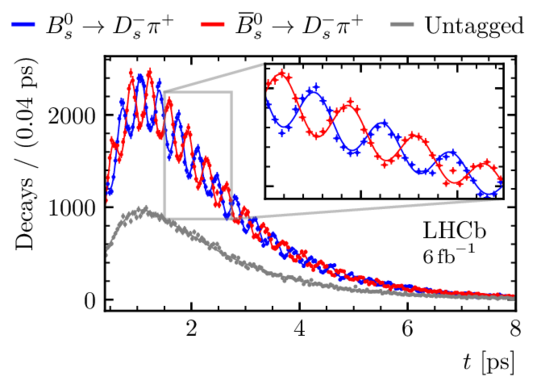LHCb CP violation
One of the big open questions in particle physics is what causes the matter-antimatter asymmetry in the universe.
In the CPV group at Dortmund, we seek to learn more about this question by investigating the different decay rates between neutral B mesons and their antiparticles. We measure the asymmetry in time-dependent and time-independent studies, and also measure the branching ratios as preparation for future work.
In addition to physics analyses, many members of this group also help develop and test the framework for determining the initial flavour of the B meson when it was created, so that we can look for mixing of particles and antiparticles in the decay over time. The Dortmund group has made major contributions to the new Inclusive Flavour Tagger and its framework for LHCb's Run 3.
Most precise measurements of the oscillation frequency of neutral B mesons
Neutral mesons can make transitions between their particle and antiparticle states through the weak interaction. This behavior was first observed in 1964 in the system of neutral kaons. Since then, these so-called oscillations have also been observed in the system of neutral B(s) mesons and at the LHCb experiment in D mesons.
Accurate knowledge of the oscillation frequency not only contributes to precision tests of the standard model, but also substantially reduces systematic uncertainties in decay-time dependent measurements in the region of neutral mesons, which are performed at the LHCb experiment to measure CP violation. Currently, the most precise measurement of the Bs0-Bs0bar oscillation frequency Δms=(17.7683±0.0051±0.0032)ps-1 has been performed at the LHCb experiment using flavor-specific Bs0 -> Ds- pi+ decays. In addition to providing the largest data set of Bs0 decays, the LHCb experiment also provides a high decay time resolution of less than 50fs, which is necessary for a measurement of this precision.
This measurement includes a number of aspects typical for decay-time dependent measurements at the LHCb experiment, which are also clearly visible in the data (see Fig.). After signal extraction, in addition to exponential decay, a decay-time dependent efficiency of reconstruction and selection has to be modeled, which is especially noticeable for small decay times. Furthermore, the state of the B(s)0 mesons at the time of their generation is determined by so-called flavor tagging, a technique based on machine learning algorithms. Together with the knowledge of the state at the time of their decay, which in the case of flavor-specific Bs0 -> Ds- pi+ decays can be deduced from the charge of the daughter particles, the mixing state of the Bs0 mesons can thus be determined. The amplitude of the oscillation visualized in this way is essentially damped by two factors. First, the flavor tagging algorithms cannot provide an exact prediction, and second, the finite decay time resolution plays a role. Nevertheless, at the LHCb experiment, thanks to large contributions from our group, it has been possible to measure the oscillation of neutral Bs0 mesons with unprecedented precision.


